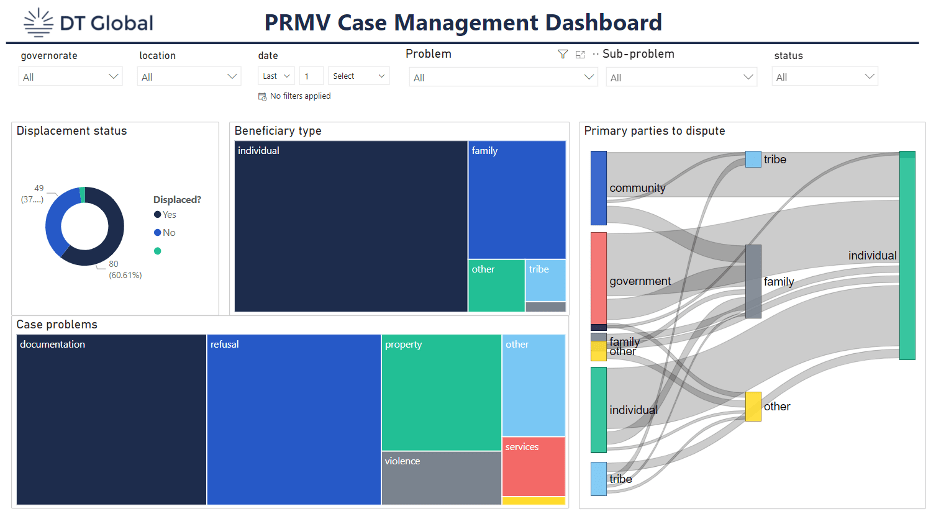
As COVID-19 lockdowns set in around the world last year, DT Global’s team in Iraq quickly realized they would need to adapt to their new reality. The Preventing Retribution and Mitigating Violence (PRMV) program, funded by Global Affairs Canada, works to resolve local conflicts before they boil over into violence. Without the ability to meet in-person with local partners, the team needed new tools designed to help remotely track and manage a complex program working across three provinces.
The Iraq team turned to DT Global’s Learning & Innovation Unit (L&I), which provides technical support on monitoring, evaluation, research, and learning (MERL) to project teams. Previously, the L&I team had established similar remote data collection and analysis systems in Syria and Somalia. After reviewing the project’s activity cycle, L&I proposed a solution that would leverage mobile technology and data visualization to provide the team with a steady flow of accurate, secure information from local partners without travel to the field.
The PRMV project’s approach to conflict resolution is highly localized. The team organizes and trains committees in eight districts across Iraq on conflict resolution techniques. These committees—comprised of local police, tribal leaders, and women and youth activists—are plugged into local networks and can anticipate and identify disputes before they become violent. In normal times, the team would meet with these committees regularly to understand what types of conflict the committees were working to resolve and provide additional resources and training as necessary. But the pandemic made this process impossible.
As the PRMV committee members often lacked access to computers or reliable internet access, the L&I team knew that a mobile phone-based data collection system could be appropriate. Based on previous experience with remote data collection in Syria, Somalia, and Yemen, the L&I team decided to work with SurveyCTO, a mobile app with advanced case management features.

After conducting a design session with the PRMV team, L&I built a series of forms through SurveyCTO for collecting data on the local disputes the committees were working to resolve. L&I then trained data collection teams from each committee to access forms via their mobile device and record high-level data on new disputes—without any personally identifiable information about the parties to the conflict. The dispute is then saved in an online database. This is where SurveyCTO’s case management feature comes in handy. Each logged dispute is tagged with a unique ID, allowing committee members to access the file and add monthly updates on the dispute’s status, moving it over time from pending solution to resolved.
Of course, having the data is only half the battle. To be truly impactful, the Iraq team needed an easy-to-use tool to view and filter this data for monthly reporting purposes. The L&I team decided to use Power BI, a data analytics software from Microsoft, to build a series of reports and dashboards with the SurveyCTO data. Using Power BI, the team has access to key metrics for reporting (such as the number of disputes resolved each month, the time spent working on each dispute, and the types of disputes by location) and can also run on-fly-analysis to get a deeper picture of local partners’ efforts.
A key benefit of this system is that the data directly flows from SurveyCTO into Power BI, where data cleaning and transformation occurs via a series of pre-recorded scripts (using Microsoft’s DAX scripting language). This automation saves the Iraq team significant time that would be spent compiling and cleaning this data by hand.

As in all of our engagement with project teams, the L&I team followed an iterative process to design the PRMV data collection system—a system that we hope to replicate with future projects. Based on our experience building data collection and analysis systems for projects in conflict-affected areas, including Syria, Somalia, and now Iraq, we have gathered together some best practices.
Here are a few of our key learnings:
Right-fit data: When building a data collection system, it is easy to become overwhelmed by the many different types of data that can be collected. But given the resources and time required to collect, clean, and analyze data, it is important to narrow the scope to the key data points required for the project. This is particularly important when dealing with personal information in sensitive contexts. If personal information is not absolutely required (or if you are not completely certain you can safeguard it) you should not be collecting it.
Mentorship beats training: The L&I team also needed to adapt to the new COVID normal to develop this system. Our team conducted all trainings with our colleagues in Iraq via Microsoft Teams. Over time, we realized that these one-off trainings were not having the intended effect, as the users of the system continued to face unique challenges we hadn’t predicted (such as the app not functioning on a certain mobile device). In response, we moved to a mentorship model. We set up WhatsApp groups with different users to troubleshoot issues and allowed users to come to us with problems rather than try to cover everything in a long, virtual training. This sustained engagement has led to faster learning and improvement of the system. This is a model we will continue after the pandemic.
People over technology: As data analysts and technologists, we love to geek out about the mobile phone features and fancy charts. But the reality is that our colleagues in Iraq just needed a system that worked for their very specific use case. We spent much more time trying to understand the project’s processes and unique challenges (probably several weeks’ worth of work) than actually building the tool itself (a week max). This is a subtle but important lesson—to focus primarily on the needs of the end user—that we’ll use to streamline our processes moving forward.